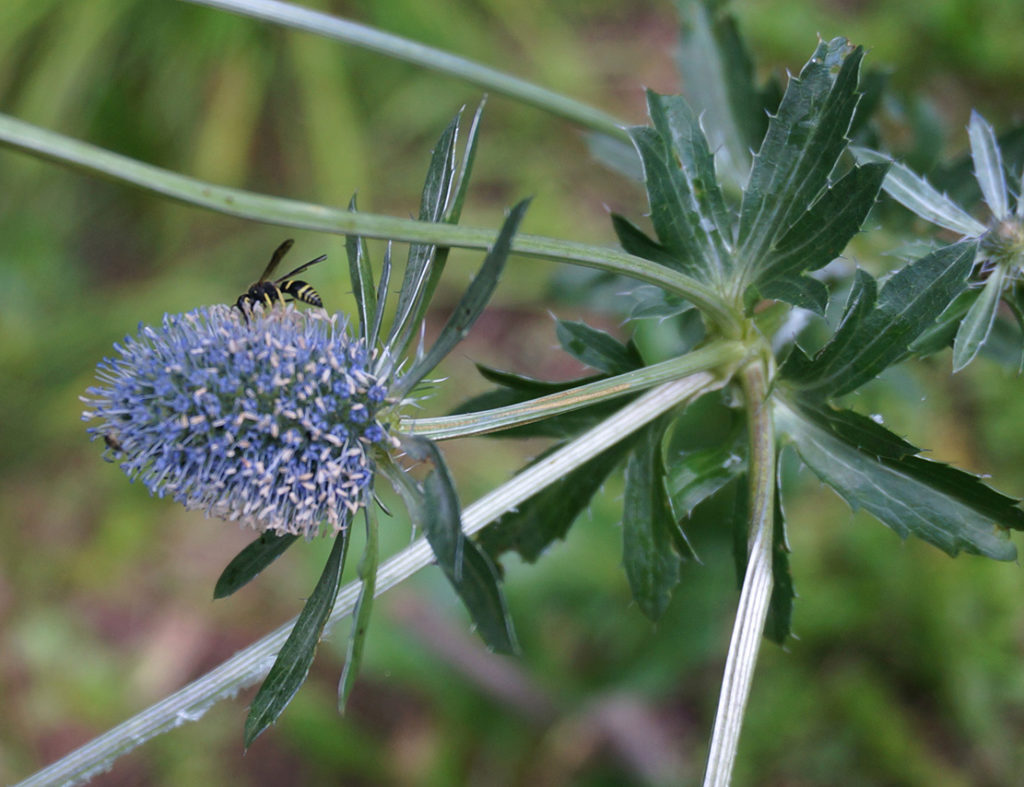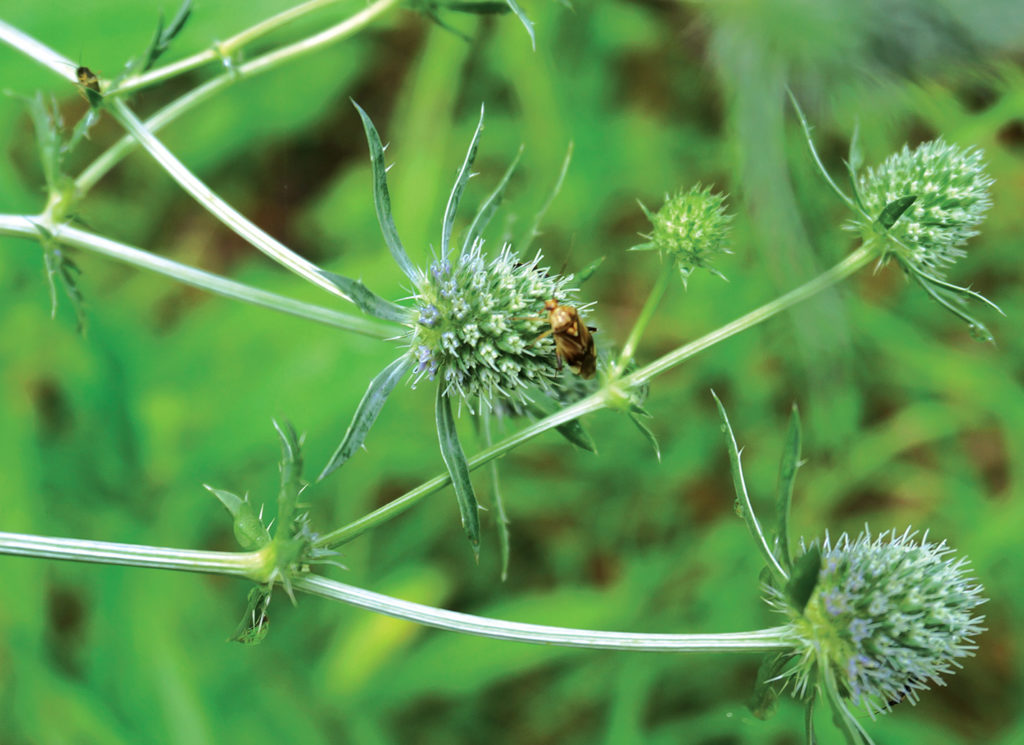The Homestead Gardener: The jungle out there
A Blooming, Buzzing Confusion
While reading a review of a new biography of Rudyard Kipling, I came across a quoted passage from The Jungle Book that seems to reflect our current moment in history. It comes in volume two, when Mowgli punishes the villagers who have mistreated the humans who once took care of him. He commands the jungle to grow at a riotously rapid rate so as to consume the village: “A month later, the place was a dimpled mound, covered with soft, green young stuff; and by the end of the Rains there was a roaring Jungle in full blast on the spot that had been under plow not six months before.”
Our moment in history is the month of August — late in the growing season, when the garden has overwhelmed the gardener and taken on a life of its own, when we abandon our feeble attempts at maintaining order and have stopped pruning those tomato plants that now tower above our heads. Remember only a few weeks ago, when we were afraid of slugs eating the newly planted out seedlings with only a few pairs of true leaves? Come August, it would take a thousand slugs working round the clock to erase this jungle.
It is this month, perhaps more than at any other time of the year, that all of our senses are overwhelmed: with the smells and colors and sounds, the whole blooming and buzzing confusion. It is a fun game to adopt an ecological point of view and talk smart about companion planting and guilds and identify the functional connections between attractors and pollinators in the complex web of life. Sure, sure. But what about those lovely pink and purple and white blossoms on the potato plants that the bees hop onto when they are done pollinating the squash and tomatoes? Potatoes do not need pollinating; strictly speaking, the flowers on them serve no function. And yet there they are, in all of their gratuitous splendor. We have to face it: Much of the vitality that we witness at this time of year is premised on the principle of art for art’s sake. Or at least it is driven in part by a vitality for its own sake, a jubilant life-force that could care less about form and function. Or maybe that is just the impression made by an overgrown garden late in the season, just past the mark when a bumper crop harvest seems a sure thing.
August is also, to me, one more reminder of what sets gardening apart from large-scale farming, the blooming and buzzing of a mixed polyculture tended by hand versus a machine-driven monoculture-by-necessity. I do not mean to moralize or pontificate. This year has been terribly punishing for most farmers in our country, with the floods and droughts and soybean tariffs, and my respect and heart-felt sympathies are with these hard-working individuals (even if I do not like the system in which they work). Crop loss and bankruptcy are disasters I would not wish upon anyone, and even the best gardeners have experienced loss on a small scale.
My only point is that a typical corn field waiting for the machine is a rather dull and quiet place for the average sensualist with seasonal cravings. There is great pleasure to be had in harvesting a little corn at a time, with one’s own hands, while walking through an overgrown jungle of tall stalks from which beans dangle like ornaments, with a bee-filled canopy of squash leaves spread out down below. Those squash leaves, of course, shade out weeds between the rows that would otherwise need pulling or spraying. There is a special logic to the Three Sisters that stands in sharp contrast to the one-dimensional logic of machine-driven farming. But right now, I just want to talk about what it feels like to be in the middle of this beautifully intertwined mess with our feet on the ground and our senses alive.
If You Plant It, They Will Come

We are all entitled to our mystical moments of bliss. But sensory stimulation and senses of oneness aside, most gardeners do indeed have their feet in the ground and fully appreciate the functional benefits of a polyculture approach to growing food. In the garden, aesthetic beauty and functionality are closely connected. Pretty flowers in and near the food garden are not “merely” pretty; they provide habitats for beneficial insects that make the health of the garden depend more on “likes” and “site visits” than on the problematic use of chemical pesticides. As the agro-entomologist C.B. Huffaker famously put it, “When we kill off the natural enemies of a pest, we inherit their work.”
There are far too many beneficial garden insects to consider here. But it is worth noting, I think, the importance of having flowers of various sizes in bloom at any given time in order to attract the full range of desired guests. As we all know, the shapes and colors of flowers have co-evolved with different types of birds and insects in long-term erotic relationships. Trumpet vine flowers have a shape that are made to order for hummingbirds, for example, and borage offers profuse clusters of blue and lavender flowers that are aesthetically pleasing and perfectly calibrated in size for honey bees and bumble bees. And the spectacular bee balm … well, the name says it all.
The work that pollinators do is well known. What about the less advertised work of beneficial insects that keep other pests in check? And what kinds of flowers attract them? These quieter members of the chorus do tend to be attracted by the smaller and less showy flowers. There is, for example, the smallish lacewing which is drawn to dill, tansy, and Queen Anne’s Lace, some of the less charismatic denizens of the garden. And then there is the ever-welcome hoverfly, attracted by the tiny flowers of sweet alyssum and buckwheat. The hoverfly and lacewing, like the ladybug, do an extraordinary job of controlling aphid populations. (It is also a good idea to have a large population of aphids for these insects’ larvae to munch on … and most gardens have an ample supply on hand by mid-season.)
The line between flower garden and vegetable garden is not always a clear one. By early July, the Spring mustards and the first round of mizuna greens have bolted in the summer heat and gotten too bitter to eat. Our first impulse may be to pull them up at the first sign of bolting so that we can plant something else. But if you let them go, and allow them time to send up their flowering stalks, I guarantee you will soon find a busy gathering of hoverflies and other beneficials sipping at their tiny flowers. I have a couple of dozen plantings of bolted dragon tongue mustard with spectacular columns of bright yellow flowers shooting up over four feet, and it is just as popular a hang-out for insects as any other flowers growing in or near the garden.
Flowers are lovely to look at, and they attract beneficial pollinators and predators as an added bonus, but the range of value-added, multi-functional benefits can extend even further. There are two flowering cover crops that I always plant in the middle weeks of summer and which do well in the heat: buckwheat and phacelia (also known as blue or purple tansy, because its lovely fern-like foliage resembles tansy). Buckwheat and phacelia do the honest practical work that cover crops generally do — protecting bare soil, controlling weeds, improving soil tilth. Both mature quickly and can easily be fit into the window between Spring and Fall planting (buckwheat typically taking the place of garlic and onions harvested in late July). The roots of buckwheat also “fix” phosphorus in the soil, which I used to think was the main reason for seeding it. But wherever I see a mass of flowering buckwheat or phacelia, I also see an astonishing amount of insect activity — bees, hoverflies, parasitic wasps, and multiple of species of each. Summer cover crops are evanescent, practical things; but they also bring color and beauty — and insects — to the garden. If you ever see a “drift” of phacelia in full bloom, moreover, you will be hard-pressed to find a more aesthetically pleasing specimen in the flower beds.
Off in the dedicated flower beds, the prize for most popular insectary flower (in my garden, at least) must be awarded to the hardy and low-maintenance perennial known as Sea Holly (Eryngium). No other flower in our garden attracts a more bewildering variety of beneficial insects than Sea Holly, whose metallic blue, thistle-like flowers begin to appear in mid to late July. Come late summer, it can be difficult to hold a conversation within close range of a patch of Sea Holly; the airborne traffic is that intense and that loud. Whenever I think of Sea Holly, in fact, I cannot help but think of other welcome visitors to my garden: the chatty, bipedal ones who often come bearing gifts in the form of seeds and plant cuttings and bulbs. I think of these guests not because of the drowned out conversations, but because of a story that has come to be associated with this flower.

Sea Holly is also known as “Miss Willmott’s Ghosts,” after the famously eccentric British gardener Ellen Willmott, who apparently loved the flower so much that she secretly scattered seeds in other people’s gardens whenever she popped in for a visit. Her spirit lives on in gardens across England that continue to be overrun in July and August with drop-in guests of all species. Some of them fly in from far away just to be there. Such stories make me love the wingless, chatty, and (occasionally) beneficial species to which I was born.
Read more online with a follow up on this topic at: https://www.owllightnews.com/some-thoughts-on-gertrude-jekyll,-pretty-flowers,-and-resilience/